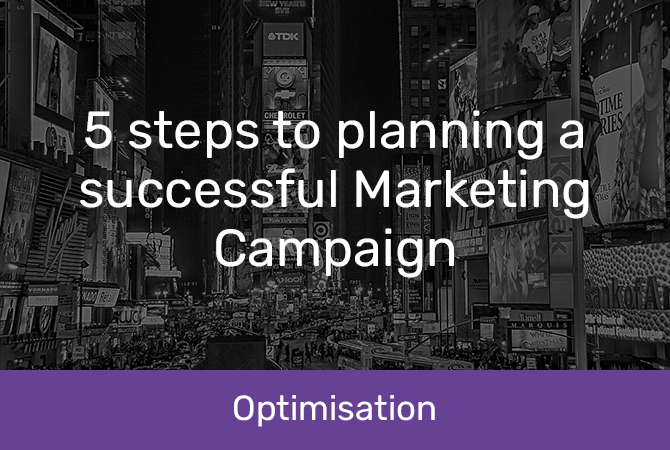
5 Steps to Planning a Successful Marketing Campaign
Regardless of their job title, department or industry, every business professional should be able to recognise the incredible value and change-driving potential of a good marketing campaign.
Consider Richard Branson as an example of someone who has deftly marketed both himself and his business, garnering attention for PR stunts such as flying around the world in a hot air balloon or posing as Elvis in Las Vegas. His dedication to creating a fun and personable brand has made him one of LinkedIn's most influential people, with nearly 19 million followers. His success is an inspiration for organisations and marketers creating campaigns around the globe.
While not every business has the internal resources to create campaigns (or is willing to carry out such extreme publicity stunts), with sufficient guidance, the process is much more achievable than it looks. Datamine’s Marketing Technologist, Andy Marsden, has extensive knowledge of the process and has outlined the five steps needed to plan a profitable data-driven marketing campaign.
 1. Define a goal
1. Define a goal
Positive psychologist Mihaly Csikszentmihalyi wrote, “A goal properly set is halfway reached.” Conversely, an endeavour lacking an objective won’t have the direction it needs to succeed. For your marketing campaign to get off the ground, it’s essential to pick one clearly defined goal that you hope to achieve with the campaign. Those who try and achieve multiple goals in a single campaign often dilute their efforts.
Questions to ask when defining your goal:
- Are you looking to improve customer retention?
- Upsell existing clients?
- Reach a new demographic?
- Or just generally improve marketing ROI?
 2. Visualise success
2. Visualise success
Once you have a goal, you need to figure out how you will measure the success of your marketing campaign quantitatively. Make sure the way you define success is a measurable metric. That means all black and white – no grey areas.
This measurement will change each time depending on the nature of your business and the campaign goal.
What does success look like for you?
- Is it a decrease in churn by 5 per cent?
- Selling 750 more products than usual?
- Or an increase of 500 engaged leads within 28 days?
In step one, you figure out the qualitative goal you’d like to reach – in step two, you determine what quantitative metrics will be used to measure whether you achieved it.
 3. campaign logistics
3. campaign logistics
It's time to get into the nitty-gritty of the campaign logistics, which means asking questions like:
- Which execution channel will you use (email, mobile push, direct mail, telemarketing, etc.)?
- What message will you use, and does it stack up commercially?
- Over what period do you want the campaign to run?
- Will it be repeated? Why?
- Do you have enough prospects?
- Is the correct system in place to be able to measure and deliver further actions and insights from your data? Quality, digestible data will ensure your campaign will not be a collection of stabs in the dark.
The second part of step three is to consider how customer behaviour will dictate the next steps of contact.
For example, if you send out an email and a person doesn’t open it, will you send a follow-up (and if so, at what point)? What if they do open the mail but don’t click on the call-to-action that takes them to your site? Having systems in place for each potential customer reaction will help avoid confusion down the road.
 4. Customer targeting
4. Customer targeting
Targeting and personalisation for relevance are now essential ways to deliver customer engagement, so take some time to outline your approach before you begin working on the creative design of the campaign.
Consider the following:
- What data are you going to use for customer targeting and segmentation?
- How will these segments look and act differently?
- From there, how will you personalise the content going out to each of these groups, making every communication feel personal and specific to the individual customer?
Emails, for example, should be personalised with the customer’s details. A great way to do this is by creating dynamic rules-based content – like changing the text and image of an email depending on the loyalty tier of the customer. Defining and delivering dynamic content to an effective level of personalisation can be challenging, but your data analyst should be able to help you through the process.
 5. Testing
5. Testing
Before you give the campaign the green light, it’s important you do enough testing (but not too much) to check whether everything is working correctly and doing what you want it to do. This final step is typically done with a combination of previewing and signing off processes before A/B testing.
As people will organically buy things, join, and churn, you will need to prove the effectiveness of the campaign.
Outlining your testing:
- Will you have control groups, and if so, what will they be?
- Are they offer-specific or global?
- What elements will you use for your A/B testing?
- How will you measure the success of the testing?
 start your campaign
start your campaign
Once you’ve laid out all of the above, you will be ready to start the campaign and see the results.
If the entire process seems overwhelming, you’re not alone – luckily, your data analytics partner should be well-equipped to lend a hand. At Datamine, we have a wealth of experience helping organisations achieve financial success and gain insight to support their marketing campaigns. We’re ready to help you build and execute a campaign offering data-driven insights and robust reporting to drive your business forward.
Dataminers believe in the value of data, and we’re passionate about helping organisations unlock their potential. To read more about optimising your campaigns, check out the Datamine Guide to Marketing Automation.
 ABOUT THE AUTHOR: ANDY MARSDEN
ABOUT THE AUTHOR: ANDY MARSDEN
Datamine Marketing Technologist Andy bridges the gap between marketing, IT, and software. He has spent over a decade in roles defining and delivering campaign management and marketing automation solutions in the telecommunications, airline, and retail sectors.















































